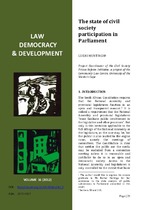The state of civil society participation in Parliament
Abstract
This paper explores the extent of public participation in the legislative, oversight and accountability mandates of Parliament. The legislative mandate refers to the making, introducing and amending of laws. The Constitution requires that the executive must account to Parliament for its actions, policies, expenditure etc. Corder et al explain it as follows: “Accountability can be said to require a person to explain and justify - against criteria of some kind - their decisions or actions. It also requires that the person goes on to make amends for any fault or error and takes steps to prevent its recurrence in the future.” Oversight has a broader meaning than accountability and includes a wide
range of activities and initiatives aimed at monitoring the executive. While accountability and oversight may differ in respect of scope and focus, it is also clear that the two are closely linked and mutually reinforcing. The last concept requiring clarification is “the public” within the sense of public participation. As will be shown below, the concept was used in an expansive manner and few restrictions were placed
on the inclusion of individuals or organisations in the review undertaken. Some may argue that, for example, national human rights institutions, such as the South African Human Rights Commission (SAHRC), are state institutions and would thus not be part of
“the public”. On the other hand it can be argued that the SAHRC has a particular mandate to prevent and protect the public against excesses of the state and that this places it more closely aligned to the interests of the public than the state. In this paper the latter view was followed.

